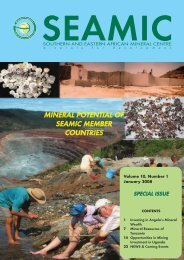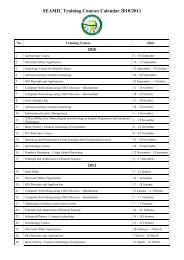SOUTHERN AND EASTERN AFRICAN MINERAL CENTRE - SEAMIC
SOUTHERN AND EASTERN AFRICAN MINERAL CENTRE - SEAMIC
SOUTHERN AND EASTERN AFRICAN MINERAL CENTRE - SEAMIC
You also want an ePaper? Increase the reach of your titles
YUMPU automatically turns print PDFs into web optimized ePapers that Google loves.
Introduction<br />
About two-third of Mozambique, including the inland areas in the north are underlain by<br />
igneous and metamorphic rocks of Archean to Neoproterozoic age. Phanerozoic terrains<br />
are found south of the Zambezi valley and along the coastal belt in the northeast.<br />
Archean and Paleoproterozoic terrains are an extension of the Zimbabwe Craton and its<br />
supracrustal, but also include granitoids, gneisses and migmatites of the Barue Complex.<br />
Two main orogenies are recognised, the Iumide belt (1800-1350 Ma) in the northwest and<br />
the Ubiquitous Mozambique Belt (1100-850 Ma), with evidence of extensive migmatisation<br />
and granitisation as well as various granitoids and supracrustals; together these terrains<br />
constitute about 90% of the Precambrian rocks of<br />
Mozambique. The Neoproterozoic Cycle (800-410<br />
Ma) is marked by the the formation of the small platform<br />
basins, as well as the influence of the Pan-African<br />
(Katangan) orogeny in the northwest, and by the<br />
emplacement of monzonites, syenites, granites and<br />
pegmatites. Carboniferous to upper Jurassic rifting<br />
associated with sedimentation and widespread igneous<br />
activity led to numerous intercratonic Karroo basins,<br />
followed by Post-Karroo continental deposits and volcanics,<br />
as well as Meso-Cenozoic continental and<br />
marine deposits, and a thick Plioctocine and<br />
Quaternary cover.<br />
Fig 1: Mineral and rock deposit map of Mozambique<br />
Geological Mapping<br />
<strong>MINERAL</strong> RESOURCE <strong>AND</strong> GEOLOGICAL<br />
INFORMATION IN MOZAMBIQUE<br />
BY NATIONAL DIRECTORATE OF GEOLOGY OF MOZAMBIQUE<br />
The economic mineral potential is largely untapped.<br />
Gold has been produced from the Archean Manica<br />
Greenstone Belt and various alluvial occurrences; large<br />
BIF deposits are also known in this terrain. Numerous<br />
pegmatite fields host important deposits of tantalumniobium,<br />
rare earths and semi-precious stones. In<br />
addition, heavy-mineral sands, graphite, flourite,<br />
apatite, bauxite, dimension stone, various clays, sands,<br />
refractory minerals, limestone, coal and natural gas<br />
form the bulk of the mineral endowment of the country.<br />
After national independence, the government of Mozambique launched an increased geological<br />
study for mineral exploration and geological mapping in the country which resulted<br />
in identification of several new mineral deposits. However, in 1983 when the civil war<br />
intensified the geological mapping and mineral exploration fieldworks were forced to be<br />
14




